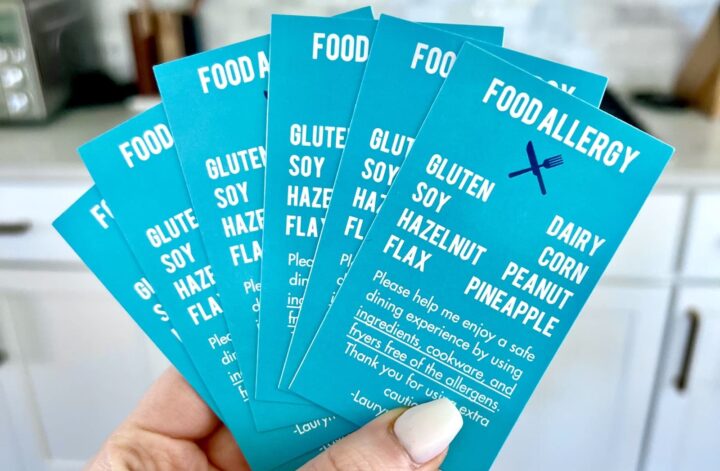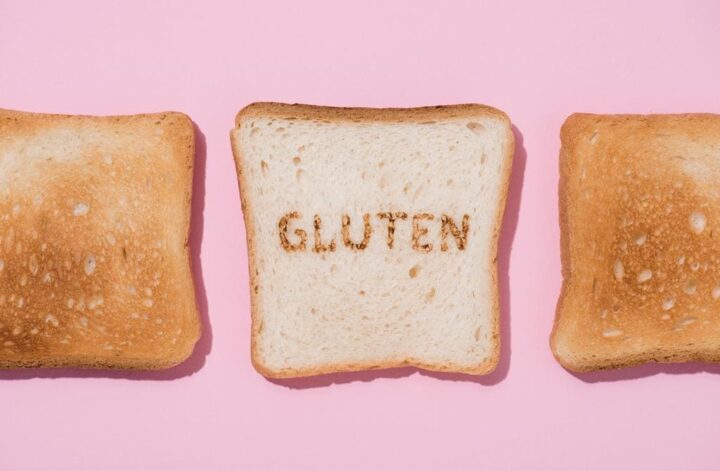Food allergies and celiac disease can make dining out a challenge. Eating at restaurants can be stressful, as you never know if the food you’re ordering contains ingredients that could cause an allergic reaction or gluten exposure. Fortunately, allergy cards can be a huge help.
Allergy cards, or chef cards, are small cards that list all of your specific food allergies. The purpose of allergy cards are to share with your server or chef to ensure they know what you can and can’t eat. Allergy cards are the single most underrated tool for people with food allergies or celiac disease. After I created allergy cards, it became so much easier to eat safely at restaurants and avoid getting glutened.
Allergy cards are also a great tool if you have a child with food allergies or celiac disease. You can share them with their school so they can keep track of your child’s allergies.
In this post, we’ll discuss how to create allergy cards for common allergens like nuts, dairy, and gluten, as well as how to effectively use them when dining out. Whether you have celiac disease or a food allergy, an allergy card can provide peace of mind and help ensure a safe and enjoyable dining experience.
Choose what to include on your food allergy card
When creating your allergy card, it’s important to include all the relevant information about your allergies or dietary restrictions. First, make a quick list of all your food allergies or intolerances. Include both common food allergies, such as nuts, fish, milk, eggs, wheat, or soy, and uncommon allergies such as pineapple or bananas.
Review your list and note your cross-contamination concerns. If you’re sensitive to cross-contamination, be sure to indicate this on your allergy card. This is especially important for individuals with celiac disease, as even a small amount of gluten can cause a reaction.

Depending on your allergies, you may want to include additional information on your allergy card. For example, if you carry an Epipen, you can note this on your card. You may also want to include emergency contact information in case you’re dining alone. The more information you provide, the better prepared the restaurant staff will be to accommodate your needs.
Food allergy cards provide the chef with context when you’re dining out. Without details, the kitchen staff doesn’t know if you have a serious allergy or simply a preference. By including your details on your allergy card, you’ll ensure that the restaurant staff is aware of your specific needs and can prepare your food accordingly.
Creating your food allergy card
Now that you know what information you want to include, it’s time for the fun part — designing and creating your food allergy cards.
You can use a food allergy card template or design your own card. I created my own template and printed them on business cards so they could easily fit in my wallet.
You can download my food allergy card template for free below. If you prefer to easily edit the template and order the printed cards, you can do that here on Zazzle with my design.
When designing your cards, here are my top tips:
- Use a simple font that’s easy to read
- Use a bold style font for all your allergies
- Use a bright background color so the card stands out
How many food allergy cards should I order?
Often I get asked how many cards to order. If you’re someone that eats at restaurants often, you may want to start with a pack of 100+. For reference, as a foodie that eats at restaurants and travels often, I ordered a pack of 500 to last me a while. Unless you ask in advance, restaurants do not usually give the cards back to you.
It’s a good idea to have multiple copies of your allergy card, so you can keep one in your wallet, one in your car, and one in your purse or bag. You can keep them in a cardholder like this to protect them from water. This way, you’ll always have a card on hand when dining out. The business card size is most convenient to keep with you at all times.

Who should you share your allergy card with?
When you’re dining at a restaurant or even attending a wedding or event, you can share the allergy card with servers and chefs. The card will help them keep track of your allergies so they can do their best to prepare a safe meal.
When I travel for work or fun, I share my allergy cards at restaurants and hotels. The cards have even been helpful in other countries, as it’s much easier for servers to translate my allergies when they’re written down.
If your child has an allergy, share the food allergy cards with their school, teachers, friend’s parents, and family. Get them in the habit of handing the allergy cards to an adult whenever there is food present.
Tips for using your food allergy cards
When using your allergy cards at a restaurant, always share them before ordering and request that the server share your card with the chef. My food allergies have been taken much more seriously ever since I started sharing the cards. Sometimes, the chef will come out and have a conversation to double-check certain items. I’ve ever had a chef catch that all their pans were seasoned with soybean oil, so they couldn’t use those to prepare my food!

When handing a food allergy card to a server, I find that this talk track works best: “Before I order, I wanted to share my food allergy card with you. I made these so it’s easier to keep track of my allergies. Could you share the card with the chef, so they can confirm what I can eat safely? I was thinking of ordering X, Y, or Z. Thanks!”
When sharing food allergy cards with friends or family, you can try this talk track: “I made these food allergy cards to help everyone keep track of my allergies. I know it can be a lot to remember, so I wanted to make it easier. Let me know if you have any questions about it.”
Importance of allergy cards
Creating an allergy card may seem like a small task, but it can make a big difference in your dining experience.
As someone who has celiac disease and food allergies, I understand how stressful it can be to eat out at restaurants. Having an allergy card with all of my dietary restrictions listed has been a game changer for me. It not only provides peace of mind, but it also helps the restaurant staff understand my needs, take my allergies seriously, and prepare my food safely.
I encourage you to create your own allergy card using the tips we discussed in this post. It’s a simple yet effective way to ensure a safe and enjoyable dining experience. Share this post with others who may benefit from creating their own food allergy card.
Are you ordering your food allergy cards? If you have any questions or comments, feel free to reach out to me on Instagram at @laurynemilia.




